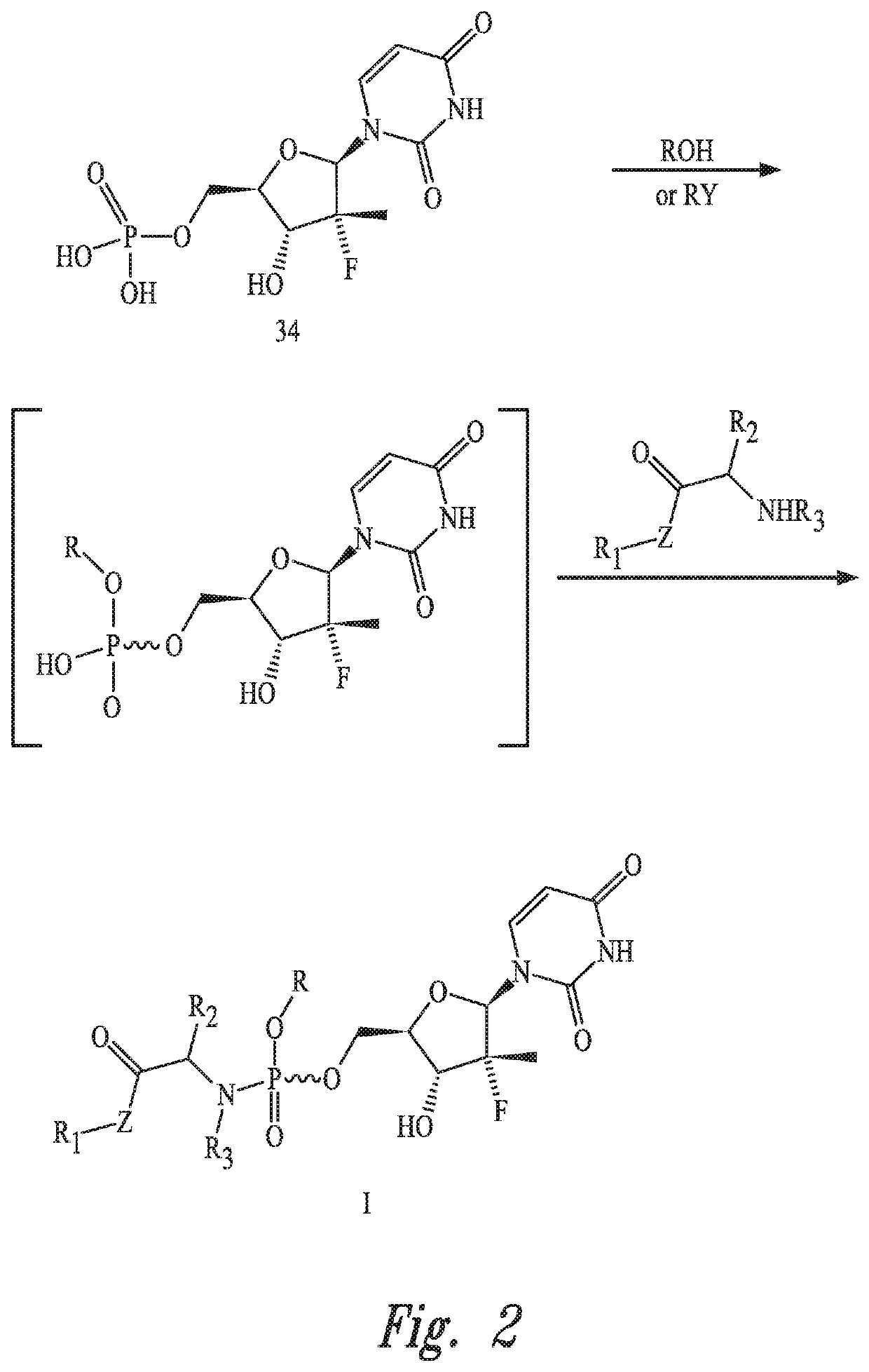Uridine phosphoramide prodrug, preparation method therefor, and medicinal uses thereof
a technology of uridine phosphoramide and prodrug, which is applied in the field of new uridine phosphoramide prodrug, can solve the problems of low antibiotic resistance of the virus thereto, and achieve the effect of reducing systemic toxic side effects, efficient metabolism and phosphorylation
- Summary
- Abstract
- Description
- Claims
- Application Information
AI Technical Summary
Benefits of technology
Problems solved by technology
Method used
Image
Examples
example 1
on of Compound 21
[0059]POCl3 (14.2 g, 92.5 mmol, 1.00 eq) and anhydrous dichloromethane (300 mL) were added to a three-necked bottle, mixed uniformly and then cooled to −40 DEG C. While stirring at this temperature, a mixed solution of compound 11 (see raw material 11 in synthesis route 1, 10.0 g, 92.5 mmol, 1.00 eq) and anhydrous triethylamine (9.36 g, 92.5 mmol, 1.00 eq) in anhydrous dichloromethane (100 mL) was added dropwise over 30 minutes. Then, the temperature was maintained at −78 DEG C. with stirring for 2 hours. At this temperature, compound 31 (14.7 g, 87.8 mmol, 0.95 eq) and anhydrous dichloromethane (50 mL) were added to the reaction mixture, and then a anhydrous dichloromethane (50 mL) solution of triethylamine (18.7 g, 185 mmol, 2.00 eq) was added dropwise over 30 minutes. After temperature naturally raised to the room temperature, cooling was carried out to 0 DEG C. after stirring for 2 hours. A mixed anhydrous dichloromethane (50 mL) solution of compound 32 (10.2 g,...
example 2
on of Compound 22
[0061]The preparation method was the same as that of example 1, wherein the compound 11 was replaced by compound 12 (see raw material 12 in synthesis route 1). The yield was 84.9%.
[0062]1H NMR (400 MHz, CDCl3) δ 7.36-7.18 (m, 4H), 5.25-5.22 (m, 2H), 5.08-4.97 (m, 1H), 4.07-3.95 (m, 1H), 3.82-3.72 (m, 1H), 2.38, 2.37 (s, s, 3H), 1.43-1.36 (dd, J=20, 8.0 Hz, 3H), 1.27-1.20 (m, 6H); 19F NMR (400 MHz, CDCl3) δ−153.61˜−153.75 (m, 2F), −159.76˜−160.01 (m, 1F), −162.14˜−162.33 (m, 2F); 31P NMR (400 MHz, CDCl3) δ 4.02, 3.97 (s, s, 1P).
example 3
on of Compound 23
[0063]The preparation method was the same as that of example 1, wherein the compound 11 was replaced by compound 13 (see raw material 13 in synthesis route 1). The yield was 79.7%.
[0064]1H NMR (400 MHz, CDCl3) δ 7.36-7.27 (m, 2H), 6.98-6.94 (m, 1H), 6.90-6.88 (m, 1H), 5.33-5.21 (m, 2H), 5.09-4.99 (m, 1H), 4.10-4.01 (m, 1H), 3.91-3.83 (m, 4H), 1.43 (dd, J=9.2, 7.2 Hz, 3H), 1.28-1.23 (m, 6H); 19F NMR (400 MHz, CDCl3) δ−153.48˜−153.64 (m, 2F), −160.11˜−160.35 (m, 1F), −162.40˜−162.59 (m, 2F); 31P NMR (400 MHz, CDCl3) δ 3.96, 3.88 (s, s, 1P).
PUM
| Property | Measurement | Unit |
|---|---|---|
| temperature | aaaaa | aaaaa |
| temperature | aaaaa | aaaaa |
| temperature | aaaaa | aaaaa |
Abstract
Description
Claims
Application Information
 Login to View More
Login to View More - R&D
- Intellectual Property
- Life Sciences
- Materials
- Tech Scout
- Unparalleled Data Quality
- Higher Quality Content
- 60% Fewer Hallucinations
Browse by: Latest US Patents, China's latest patents, Technical Efficacy Thesaurus, Application Domain, Technology Topic, Popular Technical Reports.
© 2025 PatSnap. All rights reserved.Legal|Privacy policy|Modern Slavery Act Transparency Statement|Sitemap|About US| Contact US: help@patsnap.com



